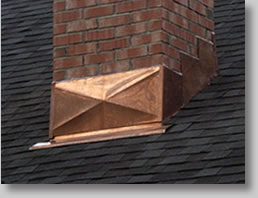Flashing - not a creepy dude in a raincoat…a key component of your roof. Strips of aluminum are strategically placed to protect vulnerable areas of your roof. Guarding your home from leaks by covering gaps along corners, around your chimney, and along the edge these key bits of metal make all the difference. Anywhere there is a bump out flashing is required. Proper installation of flashing prevents water from seeping in and wreaking havoc.

If your shingles look to be in good shape and you have a roof leak, odds are damaged, misplaced, or missing flashing is the culprit. Flashing can be damaged by wind, popping nails and wrenching flashing out of position. The caulk used in conjunction with flashing can dry out and crack over time. The flashing itself can also corrode and degrade. Any of these issues can cause water to work its way under the flashing.
In the Valley: When two roofs planes meet flashing should be placed. Most rain water will channel the most in the valleys.
Down the Chimney: This installation required skill. The smallest gap in chimney flashing can cause major headaches.
Taking a Step: Where roofs meet a vertical wall, such as a dormer, or doghouse. This flashing is most prone to rust and decay.
Time to Vent: This is generally a rubber seals with flashing around the vent pipes. The most vulnerable part to this is the rubber. Without any movement to move oils through the rubber, it dries out and cracks. It can degrade fairly quickly – within 10 years or less.
Having a thorough inspection by a professional walk your roof can discover any failing flashing. A repair before total failure can save you a significant problem down the road.

